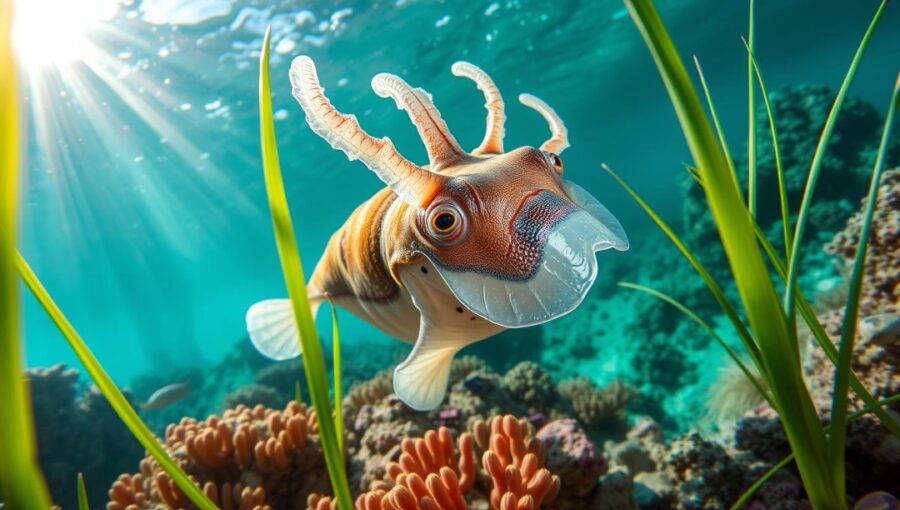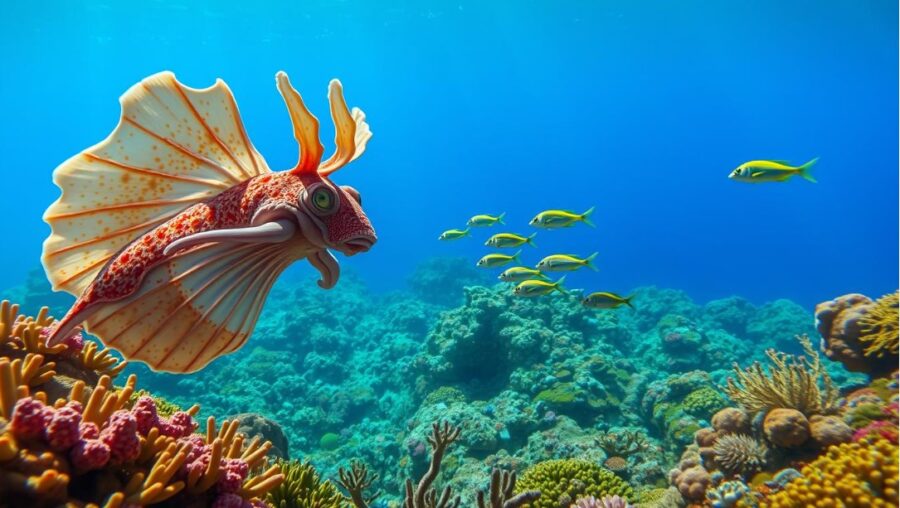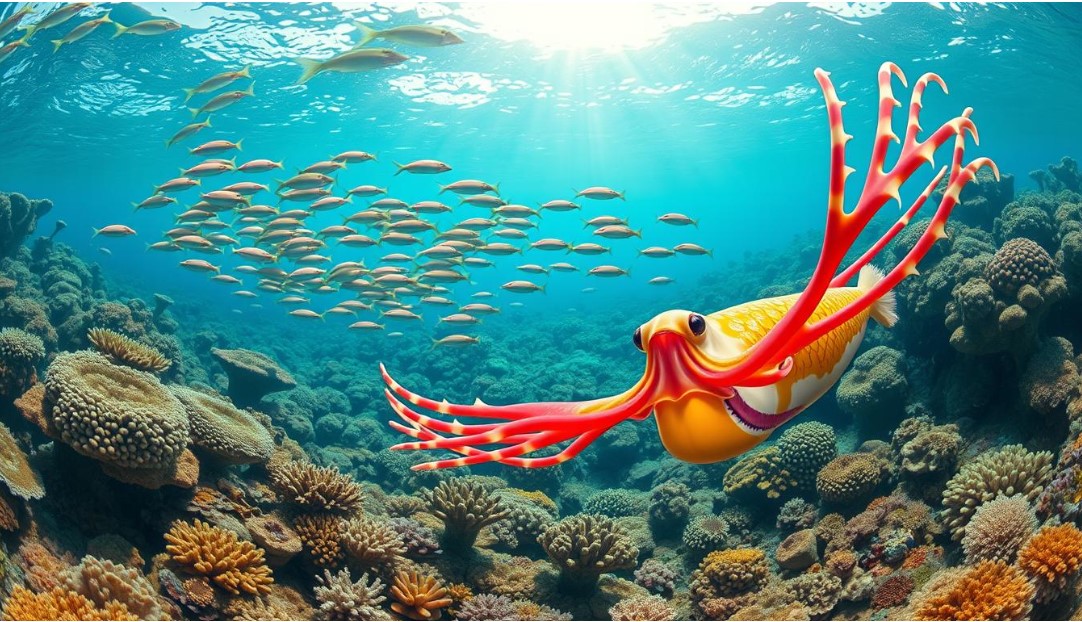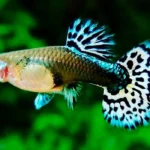Meet the cuttlefish — nature’s aquatic artists. These marine brutes belong to the cephalopod family, including octopuses and squids. What makes them stand out? Their skin can change colors in seconds, blending into coral reefs or flashing warnings to rivals.

As unique ocean creatures, they use this superpower not just to hide but to communicate, quest, and indeed trick bloodsuckers. Their smarts compete with those of some mammals, working mysteries and flashing back assignments. From their delicate cuttlebones to their lightning-fast revulsions, cuttlefish data reveal a species where biology meets brilliance.
Key Takeaways
- Cuttlefish use color-changing skin to hide, quest, and fraternize.
- They’re cephalopods with problem-solving chops and strong recollections.
- These unique ocean creatures live in abysses worldwide, from shallow reefs to deeper waters.
- Studying their disguise offers suggestions about elaboration and artificial intelligence.
- It provides data on their part in marine ecosystems and marine-inspired tech.
What Are Cuttlefish? An Introduction to These Remarkable Creatures
Cuttlefish are fascinating ocean brutes that capture the interest of scientists and divers. They belong to the species Sepiida, part of the cephalopod deconstruction family. This family also includes squid and octopuses. Their capability to change color and their smart actions make them unique in the ocean.
Classification and Family
Scientifically, cuttlefish are classified as Sepiida, with about 120 species known. This bracket places them near squid but with a crucial difference, the cuttlebone. This bone isn’t set up in the most squid cousins. Their long family history shows they have acclimated well to littoral waters.
Physical Characteristics and Anatomy
Looking at them, it has eight arms, two feeding tentacles, and a soft body. Outside, they’ve a cuttlebone that helps them stay round. They’ve three hearts and big eyes with W-shaped pupils for sharp vision.
Differences Between Cuttlefish, Squid, and Octopuses
- Cuttlefish vs squid: Cuttlefish have a hard cuttlebone; squid have a soft pen. Their arms are different too, with this using two long tentacles for catching prey.
- Cuttlefish vs octopus: Octopuses do not have a cuttlebone and only have eight arms. Cuttlefish have two special tentacles for feeding, while octopuses use all arms for stalking.
These differences show how each plays a special part in the ocean’s food web.
The Amazing Color-Changing Abilities of Cuttlefish
Imagine a critter that can turn unnoticeable in a moment or mimic a gemstone, a splint, or indeed another ocean critter. Cuttlefish are nature’s master conjurers, using their color-changing marine creature chops to survive and thrive. Their disguise is so advanced it baffles scientists — yet their eyes can’t see color. How does this work?

At the heart of their magic are chromatophores, tiny color-filled cells in their skin. These cells expand or contract like tiny balloons, mixing colors and patterns briskly than a television screen refreshes. Beneath chromatophores lie iridophores and leucophores, creating a living palette of textures and light reflections.
- Camouflage: Blends into coral reefs, beach, or seaweed in seconds.
- Communication: Flashes bold stripes to scarify rivals or subtle ripples to court mates.
- Deception: Mimics poisonous creatures like lionfish to wisecrack bloodsuckers.
Then’s the twist cuttlefish are colorblind. Their smarts use discrepancy and patterns, not tinges, to match surroundings. Experimenters at the Marine Biological Laboratory discovered they “ see ” the world in black and white but still outperform humans at pattern matching. A 2023 study revealed their skin cells reply to light changes without brain input — an evolved-in survival autopilot.
“ It’s like their skin has a mind of its own. ” – Dr. Sarah Wilson, cephalopod geste experimenter
From caching in plain sight to dazing displays, its skin is a living oil. These color-changing sensations remind us that the ocean’s most brilliant tech is still biology.
Cuttlefish Intelligence: The Brainiacs of the Ocean
Forget what you know about ocean brutes, cuttlefish aren’t just color-changers. Their brain powers are competing with some mammals, making them stars of marine beast cognition research, an organ.

Problem-Solving Capabilities
Lab trials show cuttlefish crack mysteries like pros. This is how they do it
- Unlock jars to get food
- Navigate mazes briskly than fish
- Watch others break tasks and copy them
“ Cuttlefish break challenges as snappily as octopuses, their cephalopod relatives. ” – Marine Biologist Dr. Lena Torres
Memory and Learning Abilities
These smart cephalopods flash back details humans might overlook. They
- Feed caregivers after weeks
- Flash back dangerous bloodsuckers
- acclimatize stalking strategies grounded on once miscalculations
Studies prove they retain spatial charts of their homes, a skill rare in short-lived species.
Tool Use and Adaptive Actions
Wild cuttlefish use their brainpower to survive. They:
- mound monuments to block escape routes of prey
- disguise using debris from their terrain
- Modify hunting tactics when old styles fail
Similar creativity hints at how their intelligence helps them thrive in changeable ocean territories.
The Hunting and Feeding Habits
Every day, cuttlefish in the ocean use creativity to hunt for food. Their diet includes shrimp, crabs, and small fish. They catch these using smart strategies, getting top bloodsuckers in their ecosystems.
Preferred Prey and Hunting Techniques
These creatures have two ways to hunt. First, they blend into their surroundings with skin patterns. They stay still until prey comes near. also, they strike with fast tentacles.
Their beak, like a pantomimist’s, gashes food into pieces. A crucial tool is the radula, a tongue with teeth. It grinds reflections into lower bits.
The Hypnotic Hunting Strategy
Scientists call this the hypnotism hunting fashion. Before attacking, it flashes various swells across their skin. This cephalopod feeding trick disorients prey, inducing it long enough for the cuttlefish to strike.
Experimenters compare this to a hypnotist’s performance. It leaves victims unfit to reply.
Reproduction and Life Cycle
Cuttlefish lovemaking is a varied and strategic event. In cephalopod reduplication, males compete to attract ladies. They flash bright colors and sneak once rivals. Ladies also choose a mate, occasionally sleeping with multiple males in a complex cotillion.

- Sleeping Rituals: Males show off electric colors to impress ladies. Some indeed pretend to be ladies to avoid rivals.
- Egg- Laying: Habits After fertilization, ladies cover cuttlefish eggs. They attach them to jewels or seagrass. The eggs door into bitsy, completely formed kids.
The lifetime is very short, most live only 1- 2 times. This short time pushes them to grow presto and breed snappily. By 6 months, numerous reach maturity, fastening on reduplication before their bodies stop working after breeding.
Every egg starts a new generation. Their lives are filled with beauty and briefness, leaving a lasting mark in ocean ecosystems around the world.
Habitat and Distribution: Where Do They Live?
Learning about cuttlefish niche shows how they fit into marine life. They live in warm, shallow waters but also in deeper zones. Let’s see where these smart brutes live.
Ocean Regions and Depth Preferences
It live in tropical and temperate waters. They’re set up in the Mediterranean, the North Sea, and the Indo-Pacific waters. For illustration, flamboyant cuttlefish love Southeast Asia’s coral reefs. European cuttlefish prefer the Atlantic and Mediterranean.
They like different depths
- Shallow zones( 10 – 100m): Great for hunting and breeding in flaxen or rocky areas.
- Deeper zones( over to 600m): Some go deep to avoid bloodsuckers or find food.
Environmental Requirements
For cuttlefish to thrive, they need
| Factor | Optimal Conditions |
| Water Temperature | 18–28°C (64–82°F) |
| Salinity | 32–38 ppt (parts per thousand) |
| Substrate | Sandy or muddy seabeds for camouflage and egg-laying. |
They resettle with the seasons. In cold months, some go shallower, while others stay deep. These moves help them survive in their changing world.
The Cuttlebone: A Unique Evolutionary Feature
At the heart of cuttlefish deconstruction lies the cuttlebone — its internal shell made of calcium carbonate structure. Unlike the heavy shells of draggers, this shell is light and floats in water. It’s the secret behind their cephalopod buoyancy magic.
- Acts as a natural buoyancy controller
- Helps control depth without expending energy
- Habituated in raspberry coops as a calcium supplement
Imagine an erected in a submarine control panel. The cuttlebone’s chambers fill with gas and seawater. By conforming to this cuttlebone function, It glide painlessly over or down the water column. This perfection saves energy compared to constant swimming.
| Feature | Cuttlebone | Nautilus Shell |
| Material | Calcium carbonate | Calcium carbonate |
| Primary Use | Buoyancy control | Protection |
| Internal/External | Internal | External |
“ This structure represents one of elaboration’s most elegant engineering feats, ” says marine biologist Dr. Elena Maris. “ It’s a survival tool that lets cuttlefish dominate littoral ecosystems. ”
While other cephalopods like nautiluses calculate on heavy external shells, it evolved this featherlight result. The previous calcium carbonate structure also doubles as a calcium source when discarded, frequently vended in pet stores. This multi-tasking organ highlights nature’s imagination — a mix of engineering and adaptation that keeps these brutes thriving in dynamic ocean surroundings.
Communication Methods Among Cuttlefish
Like aquatic artists, cuttlefish use colors, movements, and chemicals to talk to each other. Their communication chops let them shoot dispatches without making a sound. They blend cephalopod signaling into a language as complex as any verbal exchange.
Visual Signaling Through Color Changes
By changing their skin’s colors, cuttlefish turn their bodies into living defenses. A flash of zebra stripes might advise rivals to back off. Mottled patterns gesture readiness to mate.
These cephalopod signaling displays are so precise they can indeed target specific observers. For illustration, a joker might show bold colors to a lady while displaying drab tones to a near contender.
Body Postures and Patterns
Alongside colors, it use cuttlefish body language to amplify their communication. glaring their webbed arms makes them look bigger during competitions. When hunting, they flatten their bodies to mimic flatfish, a marine beast camouflage trick that tricks prey.
Each disguise works like a word in their silent vocabulary.
Chemical Communication
Indeed, unnoticeable signals play a part. They release chemicals into the water to mark homes or attract mates. These scent trails loiter, letting others “ read ” their intentions long after they’ve moved on.
This chemical “ language ” helps them connect in ways light can’t reach.
Together, these styles form a system as intricate as mortal discussion. Whether through shimmering patterns, postures, or aquatic trails, it prove that talking doesn’t bear a voice.
Cuttlefish in Human Culture and History
Cuttlefish have been important in mortal culture for thousands of years. They’ve inspired art, myths, and everyday life. People from ancient times to the moment have been fascinated by them.
In ancient times, Mediterranean mariners and Asian fishers saw them as mysterious and magical. They believed it could change shape and guard the ocean.
Sepia essay, made from this, has been used for centuries. It’s valued for its continuing color. The word “ photograph ” comes from the cuttlefish rubric.
A 15th-century Venetian painter wrote
“The essay of the cuttlefish holds color for eternity, outliving indeed the strongest colorings. ”
This essay was used in old calligraphies and oils. It made cephalopods a part of art history.
Cephalopods have been in art for a long time. They are seen in ancient Greek vases and Japanese prints. moment, artists still find alleviation in their capability to change shape.
In food, it adds flavor and color to dishes. Mediterranean dishes like risotto al Nero di Seppia use it. Japanese sashimi and Indonesian sotong Goreng also feature it.
- Mediterranean Essay- Stained pasta and stews
- East Asia Fresh sashimi and grilled meditations,
- ultramodern media featured in flicks like “ The Shape of Water ” and pictures
From old myths to modern pictures, cuttlefish are symbols of change and wonder. They show their lasting connection to our imagination.
Conservation Status and Threats to Cuttlefish Populations
Despite their clever adaptations, it face growing pitfalls. Pollution, overfishing, and climate change are pushing numerous species toward marine population decline. Scientists prompt action to cover these intelligent brutes before it’s too late.
“ Every time, plastic waste and warming waters disrupt cuttlefish breeding grounds, altering delicate ecosystems. ”
Current Population Trends
Species like the European common cuttlefish have seen sharp declines in recent decades. Overfishing and niche loss drive these trends. Conservationists track intimidating marine population decline in crucial fishing regions like the Mediterranean and Southeast Asia.
Human Impacts on Cuttlefish Habitats
- nethermost trawling destroys seabed territories they calculate on for sanctum.
- Ocean pollution goods include microplastics congesting their feeding grounds.
- Coastal development blocks nursery areas critical for juvenile survival.
Protection Efforts and Initiatives
Associations worldwide promote sustainable fishing practices to reduce bycatch. Marine defended areas in the Red Sea and Australia’s Great Barrier Reef safeguard breeding zones. Experimenters label individualities to study migration routes, abetting cuttlefish conservation strategies.
Every small action helps. Choosing sustainable fishing certified seafood supports these sweats. guarding cuttlefish means conserving marine biodiversity for unborn generations.
Keeping Cuttlefish as Pets: Challenges and Considerations
Allowing about getting a pet cuttlefish? These smart ocean brutes are fascinating, but they need special care. Before you decide, learn about the fantastic pet conditions and marine beast care they need to thrive.
Keeping it as pets at home is a big task. You will need a cephalopod terrarium that meets their requirements. The tank should be at least 100 gallons and have top-notch filtration to keep the water clean. You also need to control the temperature nearly, and feed them live prey like shrimp or small fish. Chancing wild-caught food can be tricky.
- Tank Setup: Requires technical outfit, including protein dessertspoons and chillers.
- Diet: Daily feeding of live or fresh seafood.
- Lifetime: most species live only 1 – 2 times.
There are also legal issues to consider. Some places need permits to enjoy cuttlefish, and catching them in the wild is frequently banned. Their short life and complex requirements make them a challenge, indeed for educated keepers. It’s hard to replicate their natural territories at home.
Still, suppose about supporting cephalopod terrarium exhibits at public places, If you are drawn to it. These places offer better care and help with conservation. It’s a way to appreciate these brutes responsibly, either by visiting them in their natural niche or at accredited zoos.
Conclusion: Why Cuttlefish Continue to Fascinate Scientists and Ocean Enthusiasts
Cuttlefish are truly fascinating brutes. They can change color, break problems, and have unique biology. Scientists study their smarts to learn about literacy and memory. masterminds look at their skin for new disguise tech. These cephalopods give us suggestions about elaboration and adaptation. They could help shape the unborn robotics and accoutrements wisdom. Their survival is linked to the health of our abysses.
Guarding their homes is pivotal for ocean conservation. Pollution and overfishing hang them, but there is a stopgap. Supporting marine conservation groups or visiting fences can help. Cuttlefish show us the prodigies of the ocean. Their stalking balls and secret rituals are witching. They educate us about survival and invention. There is always further to learn about these shape-shifting ocean ministers.
Frequently Asked Questions:
What are cuttlefish and how are they classified?
These are amazing ocean brutes in the class Cephalopoda and family Sepiidae. They’re close to squids and octopuses. They’ve a special bone called the cuttlebone and can change color swiftly.
How do cuttlefish change color?
Cuttlefish change color with special skin cells called chromatophores. They can show numerous colors and patterns presto. This helps them hide, talk, and find mates.
Are cuttlefish considered intelligent creatures?
Yes! Cuttlefish are veritably smart, working problems and flashing back effects well. They’re as clever as octopuses and other smart creatures.
What do cuttlefish eat?
This eat crustaceans, fish, and small ocean creatures. They use color changes and special patterns to catch their prey.
How do cuttlefish mate and reproduce?
Sleeping for cuttlefish is complex. Males show bright colors to attract females and eclipse other males. Ladies also lay eggs on the ocean bottom.
Where can cuttlefish be set up?
Cuttlefish live in tropical and temperate littoral waters, like the Mediterranean and Indo-Pacific. They like shallower waters but can go deeper.
What’s the function of the cuttlebone?
The cuttlebone helps cuttlefish stay buoyant. They can change the gas-to-liquid rate in their chambers to control their depth.
How do cuttlefish communicate?
It uses color changes, body postures, and chemical signals to talk to each other. They shoot dispatches about lovemaking or peril through these signals.
How have cuttlefish been represented in mortal culture?
Cuttlefish have been in art and stories for a long time, especially in Mediterranean and Asian societies. They’re also prized in cooking for their unique taste.
What are the major pitfalls to cuttlefish populations?
Cuttlefish face pitfalls like overfishing, niche loss, climate change, ocean acidification, and plastic pollution. These troubles need critical conservation sweats.
Can cuttlefish be kept as pets?
Keeping cuttlefish as a pet is grueling. They need special care and food. Their short lives also make them hard to keep as pets, making fences better for them.










